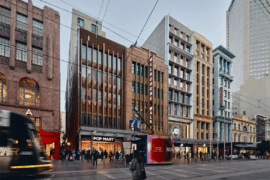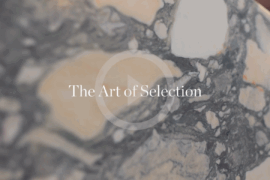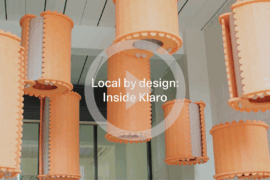With her recent registration, Tiana Furner is among the first cohort of Indigenous women registered as architects in Queensland and indeed Australia.

December 11th, 2024
Wiradjuri and Gomeroi woman, Tiana Furner, grew up in the small town of Werris Creek in northeast New South Wales – “a pretty humble upbringing,” as she describes it, drawing attention to the small community lifestyle that has always been familiar to her family. Now based in BVN’s Brisbane studio, Furner is making significant strides on the big-city architecture path. She was officially registered as an architect on November 1st but has been working at BVN for six years.
“I think my pathway to where I am now is not the common story for people within the architecture industry,” explains Furner. For me, the passion for architecture came from growing up in public housing until I was nine. That’s when my parents bought their house in Werris Creek and I think that was the point where I realised there there’s a strong emotional connection within architecture – that spaces can make you feel a certain way, and pretty much from that point on I just knew that when I grew up I wanted to be an architect.”

Leaving home, Furner studied at UNSW in Sydney. Despite initially finding the experience challenging in relation to where she came from and the kind of exposure to architecture that other students already had, Furner was up among the highest performing students by the time of her Master’s degree. “I feel like it’s really important for me to share that story with as many kids as I can,” she says, taking note of factors such as grades, schooling and ATAR pressures. “There are always options as long as you’re passionate.”
What Furner’s story perhaps illustrates above all is that there is no single route into the profession in Australia, and that students from different and underprivileged backgrounds can find their own way – as well as bringing their own unique strengths, insights and experiences.

“In terms of perspective, I think I’ve always been more on the emotional or social side or what architecture can provide. I believe I was one of the first people to graduate from UNSW with a Master’s in architecture specialising in social agency. I think I definitely thought about architecture differently; I was always thinking about how a person experienced the space as opposed to the structure, for example,” says Furner.
With her recent registration, Furner joins the as-yet small group of Indigenous women architects across Australia. “I think I was a bit shocked – I didn’t realise until my Principal actually let me know that I was one of the first in the country,” she notes. “We definitely have a growing community. It’s an extremely proud moment, not only for myself, but for the growing community of Indigenous architects or designers. I hope that me registering shows other people in similar roles at other firms that it’s achievable – so many of my Indigenous peers aren’t registered yet, so I want them to know that they can, and to continue to go into those higher roles within the company.”
Related: Balarinji on designing with Country

Furner is also keen to emphasise a holistic view, striving to be a well-rounded architect as well as an Indigenous leader. “I hope my registration encourages my Indigenous peers to also register, while encouraging more Indigenous voices into the built environment via university to contribute to future spaces. Not only do I want to inspire other people who could do something similar to me in the next couple of years; it’s also about advocating for greater Indigenous representation in architecture in general, because we need our voices to contribute to future spaces.”
As for future plans? “I just want to continue to develop… to be a Principal and to be just the best version of myself. So that’s my personal future goals, and then in general I want to see more Indigenous people in architecture, but also I want to see the industry expand into more regional areas. I think I’ve seen both sides of the coin – the quality of life that can be given to people who live in a city, though I can’t help but think about all of the families that don’t have access to those kind of [public] spaces, and I would like our industry and our country to start looking beyond cities.”
BVN
bvn.com.au
Photography
Josh Robenstone (BVN Brisbane), Trent Wallace (portrait)




INDESIGN is on instagram
Follow @indesignlive
A searchable and comprehensive guide for specifying leading products and their suppliers
Keep up to date with the latest and greatest from our industry BFF's!

Merging two hotel identities in one landmark development, Hotel Indigo and Holiday Inn Little Collins capture the spirit of Melbourne through Buchan’s narrative-driven design – elevated by GROHE’s signature craftsmanship.

CDK Stone’s Natasha Stengos takes us through its Alexandria Selection Centre, where stone choice becomes a sensory experience – from curated spaces, crafted details and a colour-organised selection floor.

Milliken’s ‘Reconciliation Through Design’ initiative is amplifying the voices of Aboriginal and Torres Strait Islander artists, showcasing how cultural collaboration can reshape the design narrative in commercial interiors.

Designed by Woods Bagot, the new fit-out of a major resources company transforms 40,000-square-metres across 19 levels into interconnected villages that celebrate Western Australia’s diverse terrain.

In an industry where design intent is often diluted by value management and procurement pressures, Klaro Industrial Design positions manufacturing as a creative ally – allowing commercial interior designers to deliver unique pieces aligned to the project’s original vision.
The internet never sleeps! Here's the stuff you might have missed

In creating interior spaces that enhance the wellbeing and experience of people, true responsible sourcing also considers the impact of materials and making.

A research exhibition reimagines St Kilda’s civic spaces through soft infrastructures that enhance wellbeing and urban experience.